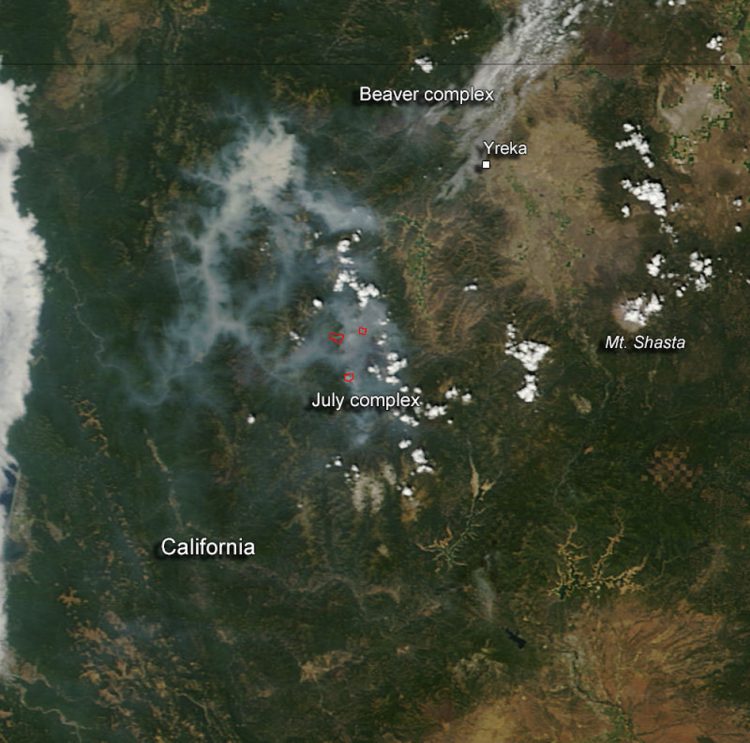Beaver Complex and July Complex Wildfires in California

After it was first discovered on July 31, the Oregon Gulch Fire rapidly moved southeast from the Cascade Siskiyou National Monument into the Soda Mountain Wilderness Area, from Jackson County into Klamath County, and then into California.
To date 35,302 acres have been affected. The wildfire complex is currently 100% contained. Per the Inciweb site total cost of this complex of fires is $20,311,646 for the Oregon Gulch Fire and $1,909,191 for the California fire. The Oregon Gulch fire burned 25,683 acres in Oregon and moved into California where it burned 9,464 acres.
It is now 100% contained. The Salt Creek fire is 155 acres and is 100% contained. In this image, smoke still rises from several areas toward the top of the image, but it is thin and hazy. No hot spots (indicated by red dots) were found by the Moderate Resolution Imaging Spectroradiometer (MODIS) instrument so the smoke could be just the smoldering aftermath.
The July complex consists of the Whites, Man, Leef, and Rays incidents. The Log fire is being managed in conjunction with the July Complex and is the number one priority. The Log fire is located just north of the July complex and is obscured in this image by the smoke and clouds. The Leef fire is 100% contained and in patrol status, the Rays fire is 100% contained at 21 acres and in patrol status. The Man Fire is 415 acres and is 0% contained. Resources on the Whites fire have completed 16.5 miles of direct and indirect line of which 6.5 miles have been contained.
- Whites Fire: 30,530 acres 18% contained
- Log Fire: 3,629 acres 95% contained
- Man Fire: 415 acres 0% contained
- Leef Fire: 17 acres 100% contained
Moderate fire behavior occurred over much of the fire area today (08/20) as a result of light winds combined with a smoke cap. The relative humidity is above the threshold for significant fire behavior. On slopes that were aligned with the wind, there was short range spotting, uphill runs and group torching.
This natural-color satellite image was collected by MODIS aboard the Terra satellite on August 19, 2014. Actively burning areas, detected by MODIS’s thermal bands, are outlined in red.
NASA image courtesy Jeff Schmaltz, MODIS Rapid Response Team. Caption: NASA/Goddard, Lynn Jenner with information from Inciweb
Media Contact
All latest news from the category: Earth Sciences
Earth Sciences (also referred to as Geosciences), which deals with basic issues surrounding our planet, plays a vital role in the area of energy and raw materials supply.
Earth Sciences comprises subjects such as geology, geography, geological informatics, paleontology, mineralogy, petrography, crystallography, geophysics, geodesy, glaciology, cartography, photogrammetry, meteorology and seismology, early-warning systems, earthquake research and polar research.
Newest articles

High-energy-density aqueous battery based on halogen multi-electron transfer
Traditional non-aqueous lithium-ion batteries have a high energy density, but their safety is compromised due to the flammable organic electrolytes they utilize. Aqueous batteries use water as the solvent for…

First-ever combined heart pump and pig kidney transplant
…gives new hope to patient with terminal illness. Surgeons at NYU Langone Health performed the first-ever combined mechanical heart pump and gene-edited pig kidney transplant surgery in a 54-year-old woman…

Biophysics: Testing how well biomarkers work
LMU researchers have developed a method to determine how reliably target proteins can be labeled using super-resolution fluorescence microscopy. Modern microscopy techniques make it possible to examine the inner workings…





















